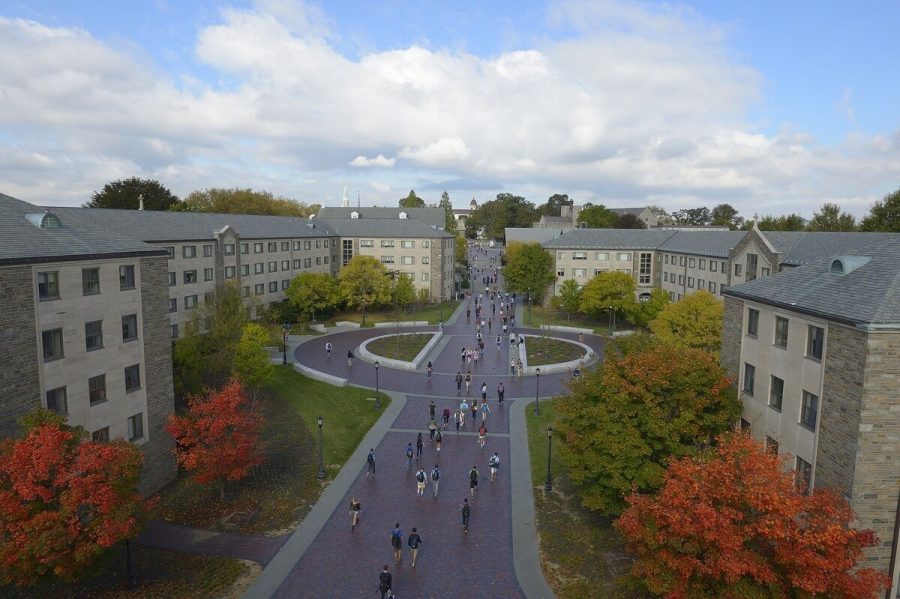Mold Infestation in Dorms Affects Students on Campus
Courtesy of Villanova University
Many of the reports for mold were made from students living in The Quad.
October 3, 2021
Something on the forefront of many students’ minds over the course of the first month living back on campus is the issue of mold in the dorms.
According to Robert Morro, Vice President for Facilities Management, reports of the mold spiked during the week of Oct. 20, when the weekly five to ten calls rose to about 50 calls. Morro explained that the hot and humid weather, including heavy rainfall throughout the week can be the source of heightened mold growth.
Morro and his team worked diligently in the summer to eliminate the possibility of mold growth. In the low rise buildings on South Campus, the maintenance team replaced the AC units for particularly the stairwells and hallways. Industrial dehumidifiers have also been placed in the residence halls. In addition, the team completed a sanitation routine known as Clorox 360, in preparation for the Fall semester.
There are unavoidable issues that can lead to mold growth. Morro explained that when freshmen move-in, the doors are often propped open during the entire day. This allows for the outside humidity and heat to enter the building and be “trapped” when all the doors close again.
Unfortunately, this campus-wide issue has led to several students moving dorm rooms due to the black mold making them physically ill. One freshman who lives on main campus stated that she and her roommate “started to feel sick” during the first few weeks of school and said that when “we heard that people had mold in their rooms, we realized we might have it also.”
When the parents of these freshman girls visited campus, they confirmed that there was in fact black mold in their dorm room. Unfortunately, these parents “had to email a few times before they actually got a real response.” The University’s response to this report of mold was to offer these girls a place in temporary housing until the issue was remedied.
While this is a reasonable response, The University “never said how or how soon they would fix” the mold issue. When talking to these girls on the Monday after Family Weekend, they still had no information as to where they would potentially move to if they moved at all. This lack of clarity from Residence Life has caused additional stress for freshmen who are still adjusting to living away from home for the first time.
If this was an isolated issue of mold growing in one dorm, then this would be a different story. Morro did explain that due to the spikes in reports, him and others from Facilities Management went to about 20 rooms. In those cases, only about 20% were found to actually have mold. He said that students will have their rooms and AC units cleaned even if actual mold is not found and that it is better to be safe than sorry.
However, the black mold has made its way into many of the other dorms on campus. Another girl reported that a close friend of hers who lives in Austin Hall had to submit a request to get the black mold cleaned off the walls of her room. The mold had spread throughout the room and was becoming a serious issue. Despite Residence Life having sent someone over to clean the mold, they “left so much more mold on her wall” and “completely missed insane amounts of mold” while claiming they had thoroughly cleaned the room. This persistent issue of mold growing in the room could potentially cause the residents of this room to become sick, which is why it is so important that the room is fully cleaned.
In yet another residence hall, several students who live in Sullivan have submitted complaints about mold and occasional cockroaches. A sophomore who lives on the ground floor of Sullivan Hall noted that when she and her roommate discovered that their AC unit was covered in mold, they “immediately submitted a request to maintenance to get it cleaned.”
The resident whose bed was in the direct airway path of the mold-infested vent began to get sick like so many other residents who had discovered mold. Their first request to have their room cleaned was denied and labeled as “a duplicate” even though they only submitted one request. Luckily, when these sophomores emailed Residence Life directly, they sent someone over to clean the mold. Even with their AC unit clean and with a new filter, the Sullivan resident voiced their ongoing fears.
“The problem hasn’t come back in our room, but I know a lot of people in our hall have experienced the same thing and have gotten sick because of it,” the resident said.
Kathleen Byrnes, Vice President for Student Life, voiced her concern for the problem and said that the school wants to ensure that reports are being answered in a timely manner. If students believe their reports are not being addressed quickly enough, Byrnes encourages students to let the facilities management team know.
“We care deeply for people’s health and safety,” Byrnes said.
Students can take precautions to avoid the spread of mold. The main thing students should avoid doing is opening their windows. Despite belief that fresh air will help, it can draw humidity into the rooms and create the perfect environment for mold growth.
Students should also avoid placing large furniture near their AC units and vents. Ideally, the AC units need about 18 inches of free space to work properly. Students should also be mindful of damp objects in their rooms, such as damp bath towels or gym bags.
If students have suspected mold in their dorm rooms, they can contact maintenance at (610) 519-4420 on the weekdays from 8 a.m. to 3 p.m. If students need help outside of these hours they can contact public safety.


